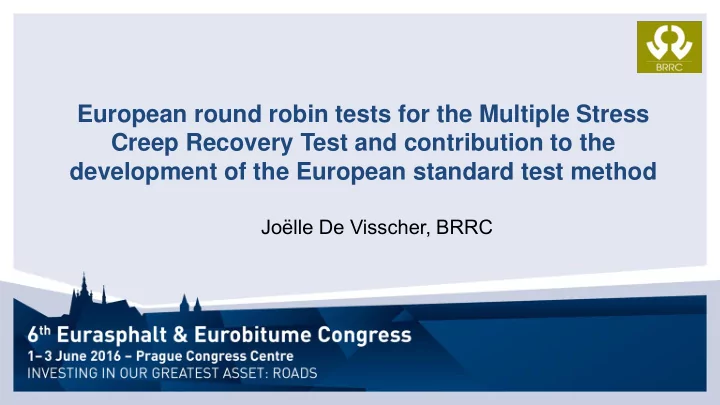

European round robin tests for the Multiple Stress Creep Recovery Test and contribution to the development of the European standard test method Joëlle De Visscher, BRRC
CEN/TC336/WG1/TG1: High service temperature properties Paez Dueñas , Antonio, Repsol, Spain Cabanillas, Pilar, CEPSA, Spain Carrera Paez, Virginia, Repsol, Spain Cerny, Radek, UniCRE-EFFRET, Czech Republic De Visscher, Joëlle, BRRC, Belgium Durand, Graziella, Colas SA, France Hagner, Tobias, TOTAL Bitumen Deutschland GmbH, Germany Lancaster, Ian, Nynas, UK 2
Context Development of the European standard test method by TG1: EN 16659: “Bitumen and Bituminous Binders - Multiple Stress Creep and Recovery Test (MSCRT)” TG1 objectives: To evaluate and possibly improve the test method To offer European labs the opportunity to gain expertise and know-how, and to contribute to the European standard To determine the precision of the test results Round Robin Tests (+ surveys) 3
Multiple Stress Creep Recovery Test Procedure: 10 creep/recovery cycles at constant stress level repeated at multiple constant stress levels (in increasing order) 4
Multiple Stress Creep Recovery Test Test results: 0,05 0,04 At each stress level (average results of 10 cycles): 0,03 e r shear strain (-) e tot Creep compliance 0,02 J nr = ε nr σ in 1/kPa 0,01 e nr % Recovery 0 0 1 2 3 4 5 6 7 8 9 10 Time (s) %R = 100. (ε r ε tot ) in % 5
TG1 Round Robin tests overview 1st RRT (2012) 2nd RRT (2014) 1 paving grade (30/45) 2 paving grade (15/25 and 70/100) 2 polymer modified (25/55-55, 45/80-75) 3 polymer modified (25/55-60, 45/80-75, 90/150-75) 1 paving grade (50/70 with 3 % wax) 1 paving grade (70/100 with 3 % wax) 1 EVA polymer modified before/after short term ageing (RTFOT) fresh binders 2 stress levels: 0.1 and 3.2 kPa 3 stress levels: 0.1, 3.2 and 6.4 kPa 1 temperature: 60 ° C 2 temperatures: 60 ° C and 70 ° C 31 (26 labs returned results in time) 28 (23 labs returned results in time) 3 repeated tests 3 repeated tests 6
Test results J nr (mean values of RRT) Paving grade bitumens Polymer modified bitumens 100 10 15/25@60°C 25/55-55@60°C 15/25@70°C 25/55-60@60°C Jnr (kPa-1) 10 Jnr (kPa-1) 1 0 2 4 6 8 25/55-60@70°C 30/45@60°C 45/80-75(1)@60°C 70/100@60°C 45/80-75(2)@60°C 70/100@70°C 1 0,1 45/80-75(2)@70°C 0 2 4 6 8 90/150-75@60°C 90/150-75@70°C 0,1 0,01 Stress (kPa) Stress (kPa) 7
Test results %R (mean values of RRT) Polymer modified bitumens Paving grade bitumens 100 100 25/55-55@60°C 80 80 25/55-60@60°C 15/25@60°C 25/55-60@70°C 60 15/25@70°C %R (%) 60 %R (%) 45/80-75(1)@60°C 30/45@60°C 40 45/80-75(2)@60°C 40 70/100@60°C 45/80-75(2)@70°C 20 70/100@70°C 90/150-75@60°C 20 90/150-75@70°C 0 0 2 4 6 8 0 -20 0 2 4 6 8 Stress (kPa) Stress (kPa) 8
Precision of test results Tables (mean values, repeatability ‘r’ and reproducibility ‘R’): see paper Observations: Ranges of r and R are very different depending on binder type (paving grade versus polymer modified binders) analysed separately Special binder results showed poor precision (specimen preparation?) not included for overall estimation of r and R 9
Paving grade bitumens: estimation of r and R 8 7 7 r and R (kPa-1) 6 r and R (%) 6 y = 0.323x 5 r (%) 5 r (1/kPa) 4 4 R (%) 3 3 2 2 y = 0.055x 1 1 0 0 0 10 20 -10 0 10 20 30 Jnr (kPa-1) %R (%) r/J nr (in %) = 5.5 % r = 0.6 % R/J nr (in %) = 32.3 % R = 4.4 % 10
Polymer modified bitumen: estimation of r and R 30 0,5 r and R (in kPa-1) r and R (in %) 25 0,4 20 y = 0.430x 0,3 r (%) r (1/kPa) 15 0,2 R (%) 10 y = 0.081x 0,1 5 0 0 0 0,5 1 0 50 100 Jnr (kPa-1) %R (%) r/J nr (in %) = 8.1 % r = 2 % R/J nr (in %) = 43.0 % R = 12 % Note: excluded from this analysis excessively high • Results at 70 ° C and 6.4 kPa for all binders • compared to other data! All results for the very soft PMB90/150-75 11
Precision data proposed for EN 16659 J nr (in % of J nr ) %R (in %) Paving grade r 6 % 1 % bitumens R 33 % 5 % Polymer modified r 9 % 2 % bitumens R 43 % 12 % 12
Conclusions on precision of MSCR test Precision was estimated for paving grade bitumens and for polymer modified bitumens Compared to precision data reported in the ASTM standard: r and R values from the European RRTs are equal or smaller Precision is negatively affected by: – Testing binders after RTFOT (short term ageing) – Increasing the test temperature from 60 ° C to 70 ° C – Increasing stress level from 3.2 to 6.4 kPa 13
General conclusions on MSCR test The two parameters identified are relevant: – J nr shows the sensitivity to permanent deformation – %R distinguishes PMBs from non modified bitumens and also distinguishes between PMBs with different levels of modification The test method is relatively fast and simple, only a few grams of binder are needed (DSR based test) A lot of European laboratories have now acquired practical experience and are capable of performing the test Precision data have now been established for Europe 14
15
Recommend
More recommend